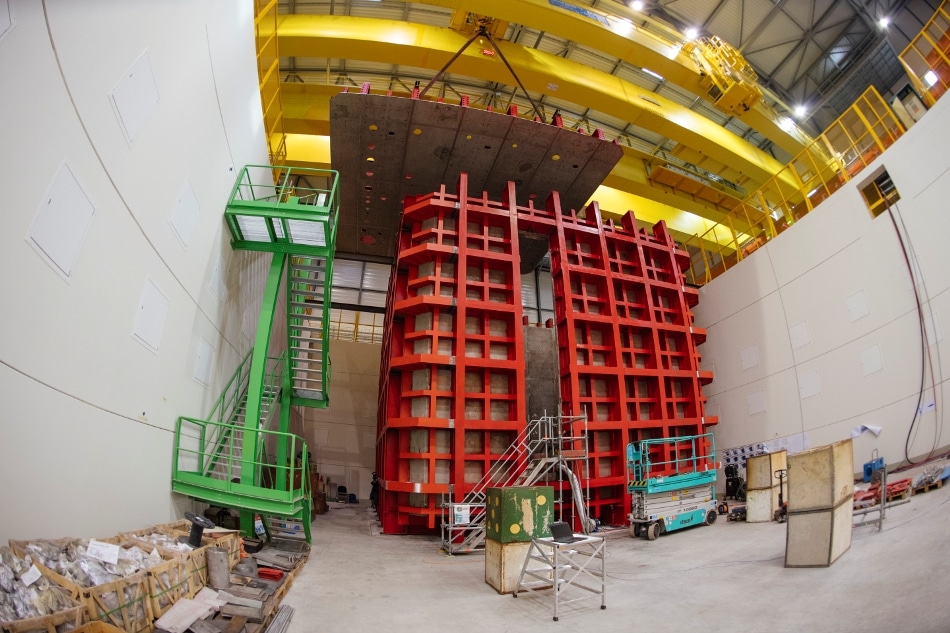Jan 11 2017
 The construction at CERN for prototypes of the future Deep Underground Neutrino Experiment detector is under way. Seen here is the outer structure of the cryostat for the single-phase ProtoDUNE. Credit: Maximilien Brice, CERN
The construction at CERN for prototypes of the future Deep Underground Neutrino Experiment detector is under way. Seen here is the outer structure of the cryostat for the single-phase ProtoDUNE. Credit: Maximilien Brice, CERN
In the midst of the verdant French countryside, there is a workshop the size of an aircraft hangar bustling with activity. In an extension that is well-lit, technicians cut through thick steel slices using electric saws and blast metal joints with welding torches.
A newest occupant found inside this building is a two-story-tall cube with thick steel walls that look like castle turrets. Ultimately, this cube will hold a prototype detector for the Deep Underground Neutrino Experiment (DUNE), which is the flagship research program hosted at the Department of Energy Office of Science’s Fermilab in order to improve the understanding of weird properties of neutrinos.
Nothing much is known about neutrinos because they rarely interact with atoms even though they are considered to be the second-most abundant basic particle in the visible universe. The only information available about neutrinos presents a daunting challenge for physicists as neutrinos are incredibly lightweight and exceptionally elusive.
They are so light that scientists are still trying to pin down the masses of their three varied types. They also constantly morph from one of their three types into another, a behavior called oscillation, which keeps scientists on their toes.
We don’t know what these masses are or have a clear understanding of the flavor oscillation. Learning more about neutrinos could help us better understand how the early universe evolved and why the world is made of matter and not antimatter.
Stefania Bordoni, CERN Researcher
CERN and the United States signed a new cooperation agreement in 2015. This agreement acknowledged the United States’ continued participation in the Large Hadron Collider research program and a commitment from CERN in order to serve as the European base for the U.S.-hosted neutrino program. Since the time of this agreement, CERN has been chugging full-speed ahead to construct and refurbish neutrino detectors.
Our past and continued partnerships have always shown the United States and CERN are stronger together. Our big science project works only because of international collaboration.
Marzio Nessi, Head of CERN’s Neutrino Platform
The main aim of CERN’s neutrino platform is to provide the infrastructure to test two huge prototypes for DUNE’s far detectors. Construction of the final detectors will take place at Sanford Lab in South Dakota. Ultimately, they will sit underground for one-and-a-half kilometers, recording data from neutrinos produced 1,300 kilometers away at Fermilab.
Two 8-meter-tall cubes that are currently under construction at CERN will each contain 770 metric tons of liquid argon permeated with a strong electric field. Two smaller, but still large, versions of the DUNE detector to be tested inside these cubes will be constructed by the international DUNE collaboration.
In the initial version of the DUNE detector design, particles passing through the liquid knock out a trail of electrons from argon atoms. This chain of electrons is then sucked towards the 16,000 sensors lining in the interior of the container. Physicists can derive the energy and trajectory of the original particle from this data.
In the second version, the DUNE collaboration is focusing on a new type of technology that introduces a thin layer of argon gas floating above the liquid argon. The idea is that the extra gas will amplify the signal of these passing particles and provide scientists a higher sensitivity to low-energy neutrinos. Currently, scientists based at CERN are developing a three cubic meter model, which they aim at scaling up into the much bigger prototype in 2017.
CERN, in addition to these DUNE prototypes, is also refurbishing a neutrino detector, called ICARUS. This new detector was used in an earlier experiment at the Italian Institute for Nuclear Physics’ Gran Sasso National Laboratory in Italy. In March 2017, ICARUS will be shipped to Fermilab and incorporated into a separate experiment.
CERN further plans to serve as a resource for neutrino programs hosted in different places all over the world as scientists continue to research deeper into this enigmatic niche of particle physics.